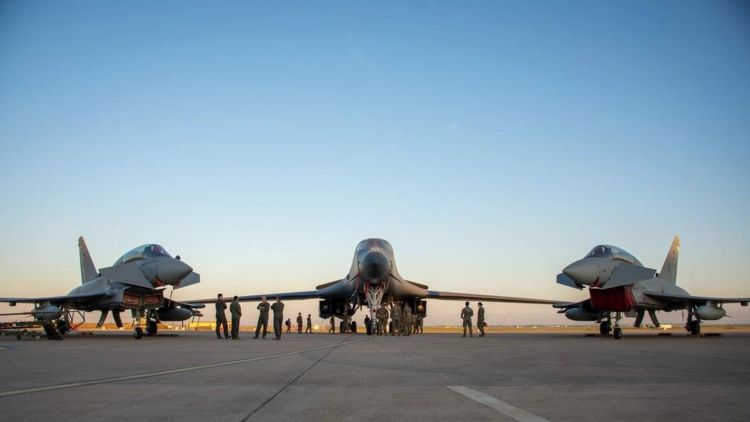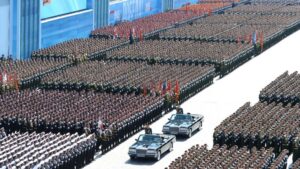The Air Force is breathing new life into another B-1 bomber from the “Boneyard” at Davis-Monthan Air Force Base, Arizona. On July 2, an aviation photographer captured images of a B-1, tail number 86-0115 and nicknamed “Rage,” taking off from Davis-Monthan.
A service spokeswoman confirmed that the bomber had been regenerated by the 309th Aerospace Maintenance and Regeneration Group and was on its way to Tinker Air Force Base, Oklahoma, for updates and depot maintenance before rejoining the fleet.
The spokeswoman said:
“At the request of Air Force Global Strike Command, Air Force Materiel Command is regenerating a B-1B to replace aircraft -0126, which was undergoing heavy structures repair development at Boeing-Palmdale.”
She added that the analysis determined regenerating an aircraft from AMARG storage could be done faster and at a lower cost than continuing the Boeing repair project.
Need for Speed
Aircraft 86-0126, nicknamed “Hungry Devil,” was assigned to Dyess Air Force Base, Texas. According to aviation enthusiasts, the B-1 was at Boeing-Palmdale to develop a depot-level repair process for the Forward Intermediate Fuselage (FIF). The spokeswoman declined to specify when “Rage” will complete its repairs and return to the operational B-1 fleet, citing operational security concerns.
A U.S. Air Force B-1B Lancer approaches a KC-135 Stratotanker as part of a regularly scheduled Bomber Task Force (BTF) mission in the U.S. Central Command area of responsibility. (U.S. Air Force photo by Senior Airman Jacob Cabanero / DVIDS)
This is the second B-1 regeneration in a few months. In March, the 7th Bomb Wing at Dyess announced it was resurrecting a bomber nicknamed “Lancelot.” This is to replace a B-1 that caught fire during an engine run in April 2022. That incident resulted in a massive fireball, sending shrapnel flying hundreds of feet and causing the total loss of the aircraft.
Future Regenerations on the Horizon
Another regeneration might be needed soon. A B-1 bomber, tail number 85-0085, crashed at Ellsworth Air Force Base, South Dakota, in January, severely damaging the aircraft. The spokeswoman said a final decision on the Ellsworth aircraft’s fate is still pending.
B-1B Lancers from Dyess and Ellsworth Air Force Base, South Dakota, sit on the flight line at Dyess Air Force Base, Texas. (U.S. Air Force photo by Senior Airman Leon Redfern / DVIDS)
If another regeneration occurs, the Air Force will have brought back three of the 17 B-1s it retired between February and September 2021. According to Air Force Global Strike Command, four retired aircraft were to be maintained “in a reclaimable condition.”
Congressional Mandates and Fleet Requirements
While Congress repealed prohibitions on retiring B-1 bombers as part of the 2021 National Defense Authorization Act. Lawmakers have passed provisions mandating a fleet of at least 92 bombers in the Primary Mission Aircraft Inventory.
They have also forbidden the Air Force from modifying the operational capability statement for any B-1 bomber squadron to reduce capability or personnel. These moves compelled the Air Force to replace any B-1 incapacitated by mishaps or years of hard flying.
The Role of AMARG
The AMARG at Davis-Monthan regularly reactivates aircraft for the Pentagon, NASA, and partner nations. Aircraft sent to the Boneyard can be maintained in various conditions, depending on whether the Air Force wants to keep the option to un-retire them.
Typically, the AMARG removes explosive devices, fills fluid lines with a preservative oil, and closes off openings. This is to prevent animals and birds from nesting. It also covers the cockpit, intakes, and exhaust with a spray-on latex preservative. This way, it can mitigate the destructive effects of sun and heat.
Resurrecting these bombers isn’t just about bringing old planes back into service. It’s about ensuring the Air Force maintains its strategic capabilities. The B-1s, even those pulled from the Boneyard, play a crucial role in that mission.
__
Disclaimer: SOFREP utilizes AI for image generation and article research. Occasionally, it’s like handing a chimpanzee the keys to your liquor cabinet. It’s not always perfect and if a mistake is made, we own up to it full stop. In a world where information comes at us in tidal waves, it is an important tool that helps us sift through the brass for live rounds.



